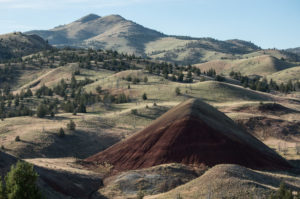by aramatzne@gmail.com | 10 Sep 2017 | Roads Taken
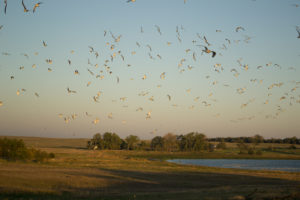
Franklin’s gulls over the apparently misnamed Crow Lake.
You never really know what you’re going to get. Central South Dakota is not exactly a hotspot. I blew through it a few times on the interstate. If you can call five and a half hours blowing through. It was just a necessity of moving from point A to point B. They raised the speed limit to 80 recently. That helps.
For a month one autumn I drove around in circles in central South Dakota. I wasn’t lost or stuck. I was looking for migrating birds. I didn’t find what I was looking for. And that was a good thing. It seems I was the one who should have been migrating.
One evening there was a horde of Franklin’s gulls, on Crow Lake. Naturally. It was dusk, the light was beautiful. In my endless circling, I saw the flocks, pushed by the wind, accumulating in the southern bay. In the air and on the water, they were everywhere.
I took this photo for the light, the motion, and the fluidity of the scene. I returned at dawn, better prepared to photograph the migrating mass, but, in the air or on the water, there were no birds anywhere.
Like this:
Like Loading...
by aramatzne@gmail.com | 9 Sep 2017 | Roads Taken
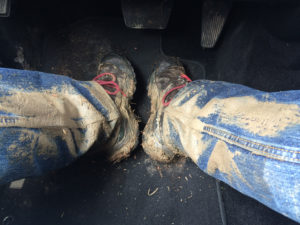
Displaying my fashion sense, I wear North Dakota.
There were two signs on the front of the building. The more prominent sign did not declare 2 7/8 as the name of the bar, but, rather, said, “ZERO TOLERANCE TO FIGHTING ON 2 7/8 PREMISES.” Welcome to fracking-boomtown North Dakota. I drove by.
That evening a massive thunderstorm piled up along the horizon, clouds towering above open plains, building strength, collecting moisture. Until, in the deepest dark of a moonless night, they had enough and let loose.
The Great Plains create some pretty vivid thunderstorms; this was a beauty. Lightning exploded across town in so many consecutive flashes I could see the length of the main street clearly for several seconds. Not just the blink of an eye that leaves you blinded and wondering if the light had been there at all, these flashes lingered. Clearly jumping from cloud to cloud and ground to cloud, there was constant light. The thunder kept pace, a steady rumble in the background with skull-crushing claps in between.
Then the rain came, pounding on the roof two stories above. The parking lot under my window disappeared behind the downpour, truck tires several inches deep in standing rain, as the drains overloaded.
The storm raged for what seemed hours, eventually tapering off as it moved across the open landscape. I fell back into fitful sleep for too few hours.
Many places become entirely inaccessible after a storm like this. Dirt roads turn to what we called Gumbo in Montana. Red dust, yellow dust, brown dirt, it’s all the same after a night like that, bacon-greased ball bearings. The collective hangover of too much.
Enter, the fracking industry, with its heavily graded and graveled roads that go everywhere, and took me where I needed to go that day. I don’t recall what I was surveying, plants or birds. I remember the landscape, wet and misty from the night’s excess. And, I remember repeatedly scraping mud from the bottom of my boots as I slid through the morning’s work. I took this photo when I realized I was wearing a large chunk of North Dakota. With my newly established fashion sense, I might fit in at the 2 7/8.
Like this:
Like Loading...
by aramatzne@gmail.com | 8 Sep 2017 | Roads Taken
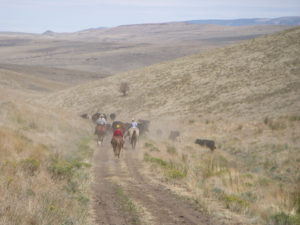
A small boy on a big horse moving cows in the Pueblo Mountains
Three riders moved slowly across the landscape, deliberately but unhurriedly they paralleled my path in the opposite direction. I watched the horses with some envy as I continued on foot.
It was July in the Pueblo Mountains. It was hot. I had been walking since dawn; it was midday now. I was out of water, out of food, and out of patience with the shadeless glare of sun-soaked sagebrush.
From a long way off I could see the horse. Even from a distance, I could tell it was a big horse. The rider was just a red dot. Eventually, the red dot became a person, a boy. He rode a few loops, lazy figure eights. He backed up the horse, made it stand and side step. Then he just sat and watched me approach.
“Where’s your horse?” the boy asked with unaffected curiosity and genuine concern.
“I don’t have one.”
“How far did you walk?”
“I don’t know. Several miles. I started at sunrise.”
“That’s a long time without a horse.”
“Yes.” We stood a minute, he on his horse, me looking at the ground. Then, diverting him from my obvious failing, “That’s a big horse.”
“I know. 17 hands. My dad told me I had to grow enough to get on him by myself before I could ride him. I’m only 7. I can’t grow that fast.”
“But you’re riding him.”
“Yup. I told my dad he better build me a ladder.”
“Did he?”
“Yup.”
“I saw three riders earlier. Was your dad one of them?”
“Yup. And my mom and sister. They said I wasn’t big enough to muster so I had to sit here and wait for them to push the cows to me. Then I can circle and ride them down the hill. We’re moving them to water.”
“You’re not big enough to muster but you’re big enough to sit this giant horse out here by yourself for however many hours it takes for them to come back?”
“I know. That’s what I said. But I lost that argument. If it wasn’t for you, I wouldn’t have anything to do.”
“You need a book.”
“I know.”
I had miles yet to cover and parted company. He sat his horse and watched me walk on.
Later in the afternoon, I watched from a slope above as the cows came, moving ahead of the three riders. The boy rode to meet them, swinging far to one side of the cows and then falling in with the other riders. He waved as he passed below me. And I took this photo of him, his mom and sister, the dust, and the cows, a scene of the west.
Like this:
Like Loading...
by aramatzne@gmail.com | 14 Jul 2017 | Roads Taken
For too many years Hart Mountain was out of my line of travel and added just enough extra time and miles to the trip at hand that I by-passed it. This spring I made the effort to go there, just there, and was well rewarded. It is a long slog from anywhere, the roads can be quagmires, the dust invasive, the heat crushing, and the mosquitoes draining. May it always remain this way.
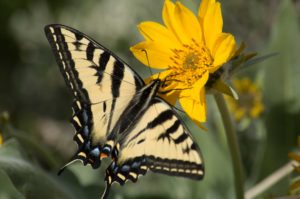
Swallowtail and balsamroot
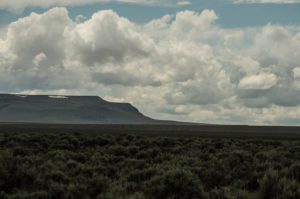
Sky drama
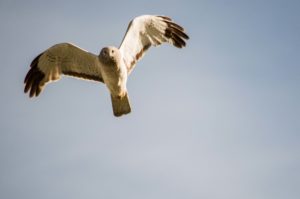
Looked down upon by a northern harrier
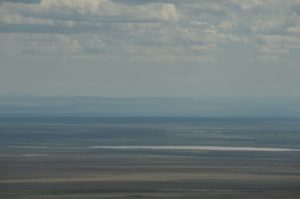
Subtle layers of color and texture
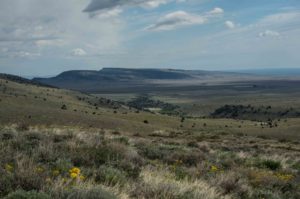
Sagebrush landscape
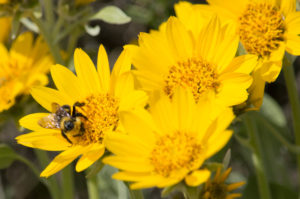
Bumblebee with balsamroot
Like this:
Like Loading...
by aramatzne@gmail.com | 30 Jun 2017 | Musing, Roads Taken
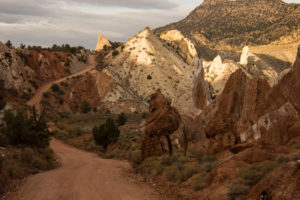
On the executioner’s block: Grand Staircase-Escalante National Monument, Utah
It is already true that one can be dropped on any commercial strip in the USA and have no idea where they are. Each is so much the same, so not unique, that Chattanooga and Bakersfield look much the same. We have eradicated the prairies, slaughtered the forests, and filled the wetlands, must we also quash the individuality of the national monuments and make them conform to the ideals of capitalism, consumerism, and corporate expansion? What of calm, contentment, and courage to step outside of the box, to appreciate the subtle realm of time, space, and light that is not under our control? Where will we go for peace when we have used up all that is wild?
You have seen my photos over the last year. Many of those photos were taken in national monuments (including the two on this page). If you enjoyed my meager attempts at conveying the intensity of these landscapes, you will enjoy this (free ebook) photographic journey through the national monuments by exquisite landscape photographers
http://landalmostlost.com/
And, I hope you will send comments in support of retaining the national monuments.
https://www.regulations.gov/document?D=DOI-2017-0002-0001
Stay the executions.
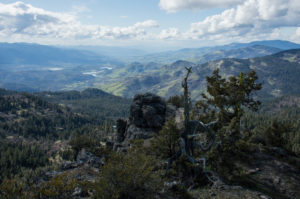
Cascade-Siskiyou National Monument
Like this:
Like Loading...












